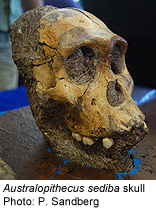
WEDNESDAY, June 27 (HealthDay News) — New research suggests that human ancestors who lived 2 million years ago had a diet that was devoted to harder foods than other early humans.
“It is an important finding because diet is one of the fundamental aspects of an animal, one that drives its behavior and ecological niche,” study co-author Paul Sandberg, a University of Colorado at Boulder doctoral student, said in a university news release. “As environments change over time because of shifting climates, animals are generally forced to either move or to adapt to their new surroundings.”
The ancestor in question is a hominid called Australopithecus sediba, or Au. sediba, an upright species that was short and gangly and lived in what’s now South Africa. Unlike its counterparts, Au. sediba ate tree bark, bushes and fruits instead of softer foods such as grasses and similar plants, the researchers believe.
An international team of investigators, led by the Max Planck Institute of Evolutionary Anthropology in Leipzig, Germany, gained insight into the diet of Au. sediba by analyzing fossilized teeth from two sets of remains with the help of a laser that freed carbon from the tooth enamel. The carbon, in turn, reveals what the species ate, the study authors explained in the report published online June 27 in the journal Nature.
The researchers concluded that these two Au. sediba individuals ate very differently than all 81 previously tested hominids.
“What fascinates me is that these individuals are oddballs,” study co-author Matt Sponheimer, a professor at the University of Colorado at Boulder, said in the news release. “I had pretty much convinced myself that after 4 million years ago most of our hominid kin had diets that were different from living apes, but now I am not so sure.”
Sponheimer added that the small sample size used in this study doesn’t provide conclusive evidence, but as more fossils are discovered, scientists “won’t have to wait another 2 million years” to perform additional research.
More information
The Smithsonian National Museum of Natural History has more about Australopithecus sediba.

